Disc Herniation
Lumbar herniated disc
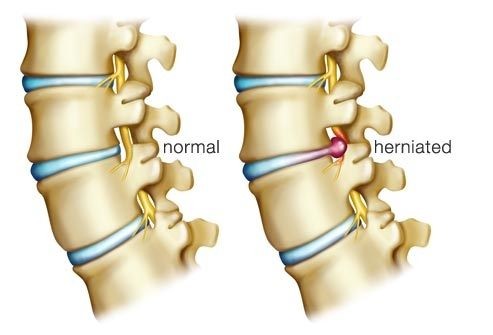
Lumbar curve consist of 5 lumbar vertebras. Between each of the lumbar vertebrae is a fibrocartilage disc that work as a shock-absorbing pad. Every disc has a tire-like outer band (annulus fibrosus) that encases a gel-like substance (nucleus pulposus). When a disc herniates, it can press on the spinal cord or spinal nerves. Disc herniation occurs when the outer layer of disc bulges, cracks or tears which allows the nucleus pulposus to escape. Indeed, The discs lose some of the fluid that makes them pliable and spongy.

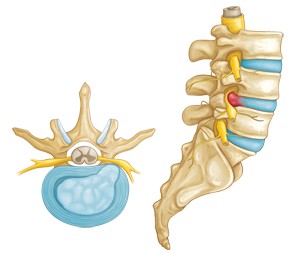
Healthy disc herniated disc
A herniated disc may be caused by:
Tear related to normal process of aging. (In young adults, discs have a high water content. As we get older, our discs begin to dry out and are not flexible).
Trauma or Injury to the spine. This may cause micro tears or cracks in the hard outer layer of the disc.
Some Risk Factors for herniated disc include:
- Gender: Men between the ages of 35 and 50 are most likely to have a herniated disc.
- Improper lifting. Using your back muscles to lift heavy objects. Lumbar rotation while you lift can also make your back vulnerable. Lifting with your legs, not your back, help protect your spine.
- Obesity. Being overweight puts added strain on the lower back discs.
- Repetitive activities with high load: Many jobs that need constant lifting, pulling, bending, or rotation placed lumbar to injury
- Frequent sitting position: after long time seated position or driving can put pressure on disc.
- Sedentary lifestyle: Regular exercise is important in preventing many medical conditions, including a herniated disc
- Smoking. Evidence showed that smoking decreases oxygen supply to the disc and causes more rapid degeneration
Signs and symptom of herniated disc:
Symptoms of a lumbar herniated disc are from moderate pain in the back and buttock to numbness and weakness of legs. In the vast majority of cases, the pain decrese within six weeks. But despite its short duration, the pain can be severe and make it difficult to contribute in everyday activities. Disc herniation symptoms usually start for no apparent reason includes:
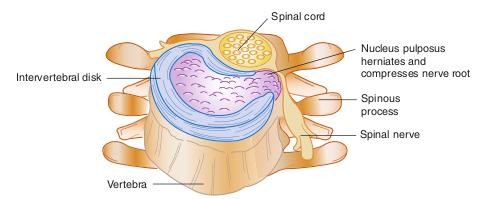
- Sciatica: Pressure on one or several nerves that contribute to the sciatic nerve can cause pain, burning, tingling, and numbness on the buttock or legs and sometimes extend to the foot.
- Lower back pain.
- Pain on the leg(s): The leg pain is typically worse than low back pain.
- Neurological symptoms. Numbness, a needles feeling, weakness, tingling may be experienced in the buttock, leg, foot, or toes.
- Pain that worsens with movement. Pain may follow prolonged standing or sitting. Sometimes a laugh, sneeze, or other sudden action may cause the pain.
- Muscle weakness in certain muscles of one or both legs
- Loss of the reflexes in one or both legs
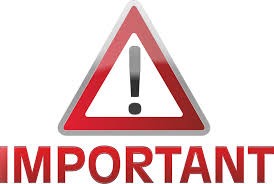
"If you have weakness or numbness in both legs along with loss of bladder or bowel control, look for medical care at once."
Treatments of herniated disc:
Treatment of a herniated disc depends on the symptoms. It also depends on whether the symptoms are getting worse or whether they are getting better. Treatment varies between conservative treatments to surgery.
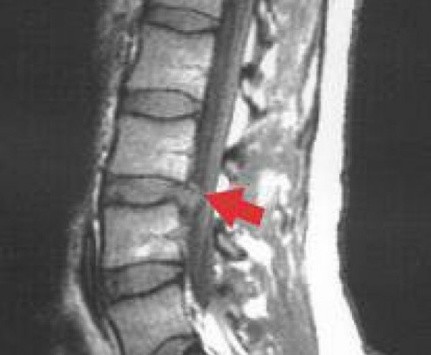
MRI indicate herniated disc
1-Observation: If the pain is bearable and there is no progression of weakness or numbness, your doctor may just suggest watching and waiting.
2- Rest: If the pain is more severe, you may need to take a few days off from work and decrease your activity for a while.
3-Pain medications: pain reliever drugs or anti-inflammatory medications may help reduce your pain.
4- Physical therapy. Specific exercises can strengthen your lower back and abdominal muscles.
5- Steroid Injection: injection is usually reserved for more severe pain due to a herniated disc.
6- Lumbosacral corsets: lumbosacral corset can support spine with transferring weight to pelvic girdle, restrict extra movement of lumbar region and reduce pain. Depending on severity of symptom, soft or rigid lumbasacral corset can be used.
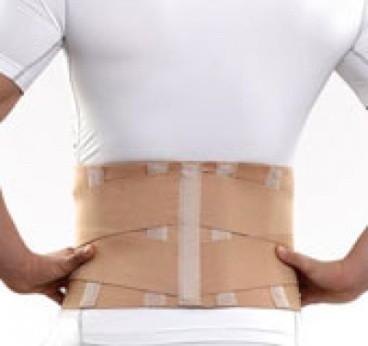
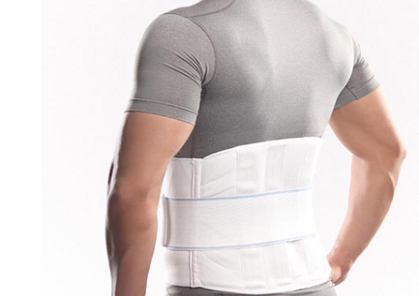
Lumbosacral corset
In the majority of cases, a herniated lumbar disc will slowly improve over a period of several weeks. Typically, most patients are improved by 3 to 4 months.
7- Surgical Treatment In the majority of cases, a herniated disc will probably not require surgery. But in cases that subjects are subjected to spinal cord injury and neurological disorders, surgery have priority.
Your comment successfully stored, thanks. Unfortunately comment storage process failed.